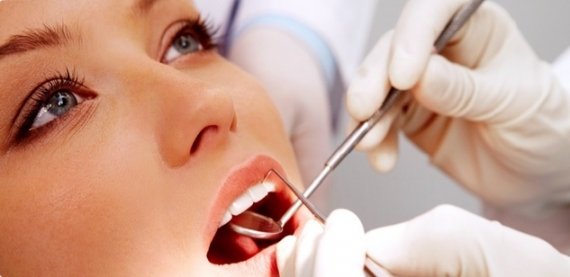Fissure sealing

Fissure sealing
Prevention of caries is of utmost importance if you want to keep your teeth healthy. Dental sealants are affective for preventing the initial forms of caries. Sealants are placed on all the hard to reach deep surfaces of the tooth.
What is fissure sealing?
Some surfaces of the tooth cannot be easily accessed with a toothbrush because of the anatomical structure. It is mainly true for the back chewing teeth (molars).
There are bumps (fissures) on their chewing surface. They can be very narrow and deep.
Deep fissures create a good environment for the oral bacteria and, therefore, progress. Bacteria, getting sugar from foods and drinks, multiply rapidly and are fixed as in dense masses, forming plaque. These bacteria produce acids that begin to ruin the tooth enamel. A toothbrush is unable to clean such deep fissures because the diameter of the brush bristles is much larger than the fissure. So it is almost impossible to clean it to the bottom.
Constant "mal-cleaning" of the plaque leads to its accumulation and the formation of dental caries. To avoid this, a dentist fills the fissures with a special sealing material.
When applied to the chewing surface of the tooth, this material (sealant) fills all hard-to-reach deep surfaces and makes them flat and smooth thanks to its liquid nature. It is a lot easier to clean plaque from such surface and this barrier prevents penetration of microorganisms that produce acid into the enamel.
The teeth are protected from decay for many years after the fissure sealing.
At what age is it best to seal fissures?
Fissure caries develops in the first few years after the teeth erupt. The first permanent molars erupt at 6-8 years, the second at 12-14 years. Therefore, fissure sealing is the most effective at this age when the teeth are not decayed. This protection of teeth will be useful for people of any age, of course, if these teeth are not decayed but fissure sealing is especially recommended for children.
In addition, there is another factor contributes to the rapid fissure destruction. The enamel of fissures and pits is not fully mature right after the tooth eruption; its mineral content is much lower than that of an adult. Therefore, these fissures are more susceptible to caries because they are much "softer" than the "adult" fissures. As a rule, fissures maturate in a year or two. The enamel of the bottom of the deep groove is thinner and less hard than the remaining enamel surface of the tooth so the tooth decay will quickly destroy the delicate enamel of such groove.
Which teeth require fissure sealing?
It is believed that the deeper fissure the more successful and useful is fissure sealing.
First, deep fissures have a higher probability of caries development. Second, the sealant penetrates better into narrow fissures. Typically, these narrow and deep fissures and pits are seen in the back teeth (the molars). Therefore, they are first susceptible to decay and require a protective barrier.
Stages of sealant application on the tooth surface
The sealant application technology is quite simple and absolutely painless. Sealant has properties are similar to composite fillings but it is more liquid. Thanks to its high fluidity, sealant penetrates narrow fissures easier.
Sealant application technology
1. Prior to fissure sealing, a dentist cleans the tooth with special rubbers and brushes, rotating at low speed. Only clean and dry surface is the key to successful sealing.
2. The tooth is isolated with cotton rolls from saliva. A special gel, which makes the surface rougher, is applied on the tooth surface for a few seconds. It increases the sealant adhesion to the enamel.
3. Then, that gel is washed off with water.
4. The sealant is applied on a dry tooth surface and is distributed over all cavities.
5. After sealant penetrates deep fissures, it is lit by a special lamp.
6. Hardened slant should not interfere with the jaw closing. A dentist will check this using carbon paper, which will show the places where there is an excess material. Excess material is removed with a help of rotating tools.
Sealant durability
According to the statistics, the results of sealant application are inspiring. The durability of sealants in the first years reaches 80%, after 5 years it reaches 70% and after 10 years it is 30%. It reduces the risk of tooth decay by 70-80%. Sealants can serve a lifetime. Often in adult patients, you can see the teeth covered with sealant, which was installed in childhood. It is believed that the sealing is successful if the sealant stays on the tooth for three to five years. However, even in the case of the earlier sealant loss, it is not a failure because all this time the sealant was protecting the tooth surface from acid-producing microorganisms and caries.
